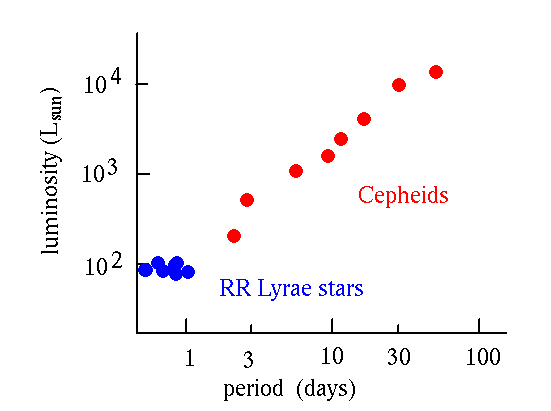Cepheid variable stars as distance indicators.
Certain stars that have used up their main supply of hydrogen fuel are unstable and pulsate.
RR Lyrae variables have periods of about a day. Their brightness doubles
from dimest to brightest.

Typical light curve for a Cepheid variable star.
Cepheid variables have longer periods, from one day up to about 50 days.
Their brightness also doubles from dimest to brightest.
From the shape of the ``light curve'' of a Cepheid variable star, one can
tell that it is a Cepheid variable. The period is simple to measure,
as is the apparent brightness at maximum brightness.
Cepheids as distance indicators
Cepheids are important beyond their intrinsic interest as pulsating
stars. Astronomers have found that there is a relation between
the period of a Cepheid and its luminosity.

This enables astronomers to determine distances:
- Find the period.
- This gives the luminosity.
- Measure the apparent brightness.
- Determine the distance from the luminosity and brightness.
The same applies to RR Lyrae variable stars. Once you know that a
star is an RR Lyrae variable (eg. from the shape of its light curve),
then you know its luminosity.
Where did this period-luminosity relation come from?
- American astronomer Henrietta Leavitt looked at many Cepheid variables
in the Small Magellanic Cloud (a satellite galaxy to ours.)
- She found the period luminosity relation (reported in 1912).
- One needs a distance measurement from some other method for
at least one Cepheid.
- The ``original'' Cepheid variable, Delta Cephei, is close enough
that we have a parallax measurement for it.
- Now the best determination is from getting the distance to the
Small Magellanic Cloud from main sequence stars located there.
- This method was not so accurate to start with, but it has been
refined over the years...
Return to Astr 123 course welcome page
Davison E. Soper, Institute of Theoretical Science,
University of Oregon, Eugene OR 97403 USA
soper@uoregon.edu


